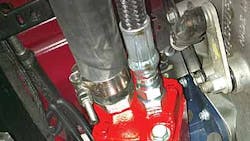Finding more room for hydraulic components when space is limited
The mobile power market today is growing. Unfortunately, the area under the vocational vehicle is not. In fact, it seems to be shrinking more and more each year.
This is not intended to make it more difficult for the up fitters or power take-off (PTO) equipment manufactures. It is an unintended consequence as chassis manufacturers seek to reduce weight and size in an effort to improve the truck's overall fuel efficiency.
The challenge for the mobile power industry is to quickly adapt to current designs and shrinking space under the truck. However, there are a few ways that the mobile power industry can deal with the shrinking space available for area. Those areas are component size, overall system layout, and new product size.
Let's take a look at the vehicle itself. It is easy to see why there is not a lot of room under the truck. In addition, there is little to no room above the frame rails. The more compact the space, the smaller the equipment needs to get.
One way we have worked around the compact space issue is by changing location. We have found ways to lower the equipment or move the equipment to an alternative location. For example, PTOs now have extended shafts. This has allowed the PTO to be mounted to the transmission aperture just like before, but with the output shaft extending back toward the rear axle where there is more room to attach a pump or motor.
Other solutions combine the PTO with a gear box that lowers the output shaft just enough so other mobile power equipment can mount and function. These solutions and others not yet available have one thing in common. They separate the equipment, in turn requiring the system to be laid out in a new configuration.
The system configurations associated with this approach typically require a longer wiring harness, longer hoses, and brackets to support the spread out equipment. Probably the toughest portion of the system layout is routing of everything safely. Not that this task has ever been easy, but it is challenging. A common issue encountered is wires shorting due to the close proximity to hot components and exhaust systems. Also wires wear if not secured properly. Care must be taken to avoid those problems. Heat shields are a good method to reduce this problem, but one more thing to attach.
Air and hydraulic hose routing is another area to be careful with. Hoses running in unconventional places are an important issue to grasp. With these uncommon routings, they need to be secured properly. They need to be snug in place to reduce fretting and wear on the outside surface. Also, if not secure and they are supported too far apart, they can fatigue at or near the fitting. Once these issues are appropriately addressed, the mobile equipment should last a long time.
The size of the equipment is a major issue. Size and weight need to shrink, but the horsepower needs to stay the same. Manufacturers of mobile hydraulic equipment are addressing these issues with new lightweight materials, part integration, and compact, tighter designs. These ideas are in process and in testing. Field application and debugging continue as well. We continue to work closely with the major vehicle manufacturers. Working closely with key players is the key to staying on top of the challenge of a shrinking volume under the truck.
As vocational vehicles get smaller and more compact (see fig. # 2), the mobile power market will need to react. The days of grabbing anything off the shelf are diminishing. The attitude of just make it work is going away. This is good news. Systems will need to be designed for particular applications. This will drive innovation and also force equipment manufactures to engineer and design more power dense products.
Efficiency is the key to our future and the long-term success in the market. Improving fuel efficiency is the growth industry for the next 50 years. The team who engineers the best, lightweight and efficient system will win. To the winner go the spoils. Good luck!
